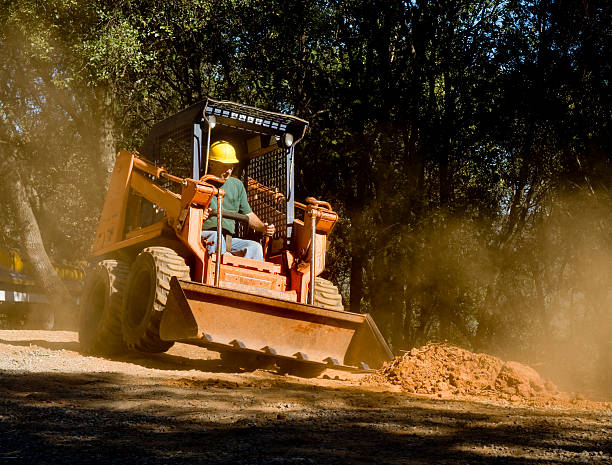Skid Steer Expertise Accelerated: Advance Your Knowledge
Operating a skid steer takes skill, practice and knowledge to become proficient. Whether you’re just starting out or looking to advance your expertise, gaining a strong foundation in key areas can help accelerate your skid steer capabilities. Let’s explore some best practices and insights to help take your skid steer knowledge to the next level.
Getting Comfortable Behind the Controls
Sitting inside the cab of a skid steer for the first time can feel overwhelming. Various levers, pedals and switches control all machine functions from driving to operating attachments. Don’t let this intimidate you. Understanding control layouts and developing coordination through repetition is the key.
Most skid steers have similar standardized control schemes consisting of drive control levers for each set of wheels, lift arm controls and auxiliary hydraulics. Study your operator’s manual and get the feel of each function one at a time before attempting to combine motions. As the configurations become second nature, start piecing movements together to perform basic tasks.
Proper Operating Techniques
Once acquainted with the controls, focus on refining operating methods for efficiency and safety. Rushed or careless operation can lead to accidents, damage and reduced productivity. Follow these guidelines:
- Check surroundings before moving – Ensure people and obstacles are clear of machine path. Use a spotter when visibility is limited.
- Smoothly accelerate and brake – Sudden direction changes risk tipping or loss of control. Feather controls for a controlled start and stop.
- Carry loads low – Raising lift arms too high with an attachment shifts the center of gravity, increasing rollover risk. Keep loads low and centered.
- Avoid overloading – Exceeding capacity strains components and makes handling difficult. Know your limits.
- Use care on slopes – Grade changes affect stability. Drive straight up/down slopes to avoid tipping sideways.
Proper Stance for Better Control
How you position yourself in the cab impacts comfort and control. Sitting improperly leads to rapid fatigue and less precise operation. Maintain good posture with:
- Feet square on pedals – If pedals are alongside seat, don’t twist at waist to reach them.
- Back against seat – Avoid leaning forward or to the side for better leverage.
- Hands on controls – Keep a solid grip to react quickly while minimizing fatigue.
- 3-point contact entering/exiting – Use grab bars and keep 3 limbs in contact with machine when mounting or dismounting to avoid falls.
Understanding Load Ratings
Skid steers can utilize a variety of attachments for digging, lifting, scraping and more. But each attachment has a maximum load capacity that cannot be exceeded safely. Overloading raises the risk of tipping, component failure and falling debris.
Load ratings vary based on where the load sits on an attachment. For example, a bucket can safely hold much more material close to the loader arms versus fully extended. Other factors like slope grade and overall machine stability also influence capacities.
Refer to your operator’s manual for rated operating capacities for standard lift heights. Learn how to determine weights of common landscape materials like dirt, gravel or mulch. An overloaded machine struggles to function, so recognizing your limits prevents damage and downtime.
Executing an Effective Site Analysis
Before starting work, conduct a site analysis to identify potential hazards and formulate a safe work plan. This only takes a few minutes but protects workers, equipment and site features from harm.
Walk the site and note grade changes, soft spots, underground utilities, overhead wires, structures, difficult access points and hazardous materials. Determine if ground conditions can support the skid steer or if compacting, grading or gravel is needed. Identify any confined space entry requirements.
Use this information to decide the safest machine path to avoid tipping or getting stuck. Select the right tires for traction. Have structures or utilities marked and shut off if working nearby. Know your emergency stops, spill containment plans and shut down procedures.
Gaining Experience Over Time
Skid steer operation requires developing “muscle memory” from repeated experience. Don’t get discouraged if you struggle at first. Stick to basics until control configurations become instinctive. Slowly add new challenges like varying terrain, tighter clearances, attachment changes or unfamiliar models.
Practice key motions during downtime. For example, drive the wheels in opposing circles to pivot turn in place. Perform forward and backward drive approaches to a stop line. Lift and lower loads with precision. This trains coordination and control for when it really counts.
Over time, operation will become second nature allowing you to handle more complex tasks. Just remember – never rush fundamentals and always prioritize safety. Regular practice makes precise operation a reality.
Maintaining Your Machine
To sustain smooth operation, your skid steer needs proper maintenance. Daily inspections, fluid checks and cleaning should become routine. Failure to maintain can lead to a breakdown, creating costly downtime.
Follow the manufacturer service schedule in your owner’s manual for periodic maintenance like oil changes, filter replacement or greasing. Keep records of services for warranty and resale value. Wash machine regularly, inspect components and perform preventative repairs to avoid small issues becoming major ones.
Recognize abnormal sounds, vibrations or performance drops signaling a problem like low fluid, damaged hoses or worn parts. Investigate warning lights or alerts. Don’t operate with deficiencies – stop immediately and have them assessed. Practicing proactive maintenance keeps you working.
Advancing With Additional Training
Looking to take your skid steer skills higher? Consider specialized operator or safety certifications to open more job opportunities. The added credentials demonstrate advanced capabilities to employers.
For example, the National Center for Construction Education and Research provides training and certification in skid steer operation. Evaluators grade you on pre-start inspections, startup procedures, driving, attachment changes, shutdowns and more. Certificates confirm your expertise on paper.
Hands-on training camps like those offered by Operator School also build real machine confidence beyond a textbook. Skills are sharpened under expert guidance with a mix of classroom and field work tailored to experience levels. Visit Operator School for more details.
Staying Alert to Stay Safe
Even highly experienced operators can develop “familiarity complacency” over time, leading to lapses in judgment or procedure. Combat this by cultivating strong safety awareness until it becomes instinctive.
Always assess your mental state before working. Distractions, fatigue or illness narrow focus. Delay operation until full attention is possible. Begin each shift by checking controls, brakes and components so defects can be addressed proactively.
During operation, stay conscious of speed, attachment position and surroundings. Use extra caution in risky situations like tight clearances, loads at height or unstable soil. Don’t assume; think through each action. Make safety the priority, no matter your comfort level.
Skid steer mastery requires patience, practice and focus. But with the right approach, your capabilities can grow exponentially over time. Stick to fundamentals, prioritize safety and invest in specialized training when ready.
Before you know it, precise machine movements will feel like second nature, allowing you to take on the most complex sites with ease. Stay alert and keep advancing your skills higher.
Want to sharpen your skid steer skills further? Visit Operator School for more details on available hands-on training camps to help take your expertise to the next level.





